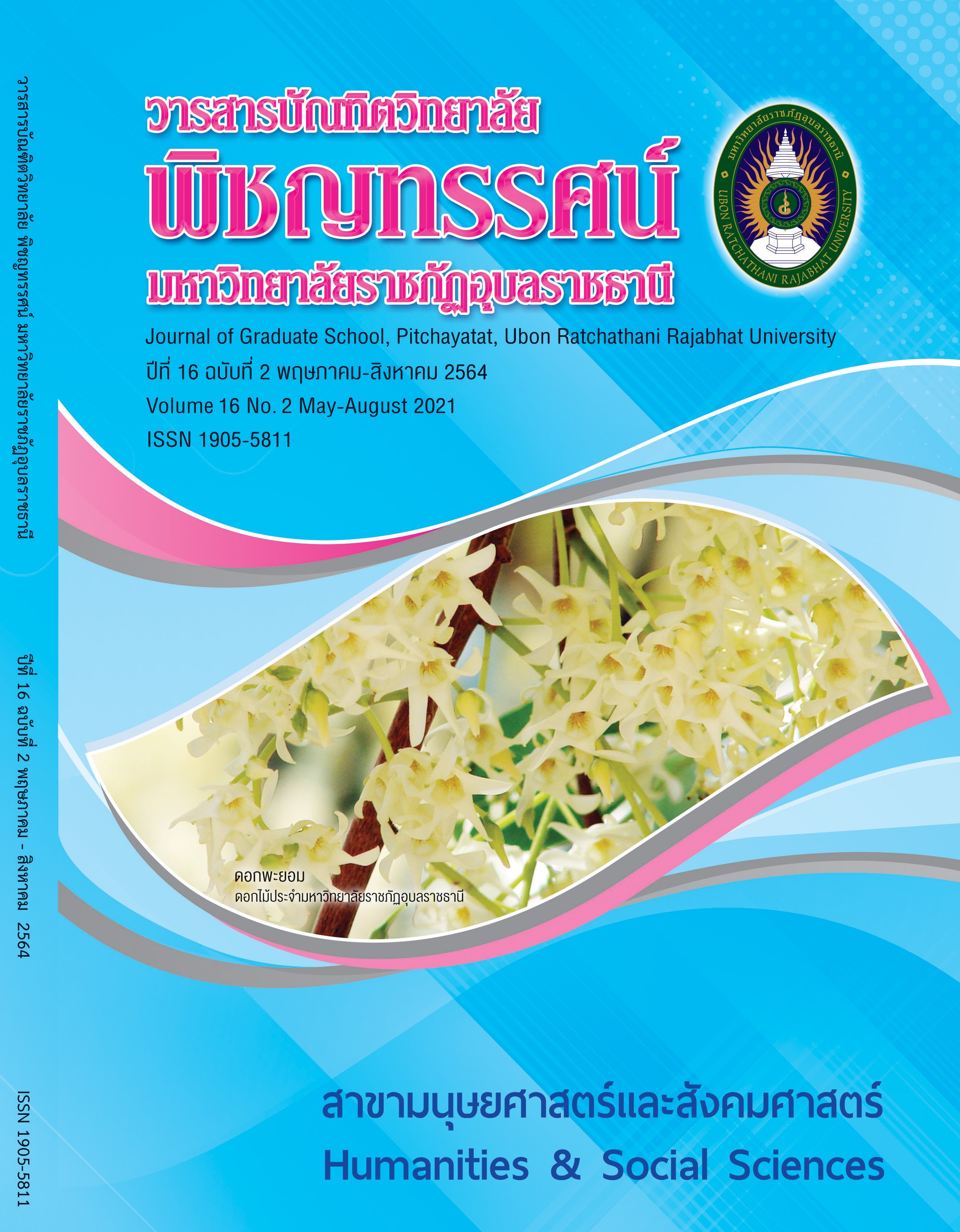การระบุรายวิชาศึกษาทั่วไปที่ส่งเสริมการเรียนรู้ของนักศึกษาด้วยชุดข้อมูลขนาดเล็ก
คำสำคัญ:
อัลกอริทึมการจำแนกประเภท, ชุดข้อมูลขนาดเล็กบทคัดย่อ
การวิจัยนี้มีวัตถุประสงค์เพื่อ 1) ระบุรายวิชาศึกษาทั่วไปที่ส่งเสริมการเรียนรู้ของนักศึกษา และ 2) เปรียบเทียบประสิทธิภาพของอัลกอริทึมการจำแนกประเภทเพื่อการระบุรายวิชาศึกษาทั่วไปที่ส่งเสริมการเรียนรู้ของนักศึกษาด้วยชุดข้อมูลขนาดเล็ก โดยใช้ข้อมูลการลงทะเบียนเรียน ของนักศึกษาสาขาวิทยาการคอมพิวเตอร์จำนวนทั้งสิ้น 1,302 คน ในช่วงปีการศึกษา 2550 ถึง 2562 จำนวน 26,804 รายการ ทำการคัดเลือกข้อมูล และนอมัลไลซ์ชุดข้อมูลด้วยเทคนิค MinMaxScaler ใช้ Heat map ในการแสดงผลการจัดกลุ่มตามลำดับชั้นเพื่อแสดงความสัมพันธ์ระหว่างตัวแปร และประเมินประสิทธิภาพของอัลกอริทึม โดยใช้เทคนิค LOOCV
ผลการวิจัยพบว่า
- รายวิชา 9021103 การรู้สารสนเทศและการเรียนรู้ และรายวิชา 9022102 ภาษาอังกฤษเพื่อการเรียนรู้ข้อมูลข่าวสาร เป็นรายวิชาศึกษาทั่วไปที่ส่งเสริมการเรียนรู้ของนักศึกษาสูงที่สุด
- พบว่า LDA เป็นอัลกอริทึมที่มีประสิทธิภาพสูงที่สุดในการจำแนกประเภทเพื่อการระบุรายวิชาศึกษาทั่วไปที่ส่งเสริมการเรียนรู้ของนักศึกษาด้วยชุดข้อมูลขนาดเล็ก
เอกสารอ้างอิง
Chao, G. et al. “A new approach to prediction of radiotherapy of bladder cancer cells in small dataset analysis,” Expert Syst. 38, 7 (2011): 7963–7969.
Ingrassia, S. and I. Morlini. Neural network modeling for small datasets. (Online) 2005 (cited 24 January 2021). Available from: https://www.researchgate.net/publication/232795375_Neural_Network_Modeling_for_Small_Datasets
Mahmoud. L and A. Zohair. “Prediction of Student’s performance by modelling small dataset size,” International Journal of Educational Technology in Higher Education. 16, 1 (2019): 1-18.
Mueen. A, B. Zafar and U. Manzoor. “Modeling and Predicting Students’ Academic Performance Using Data Mining Techniques,” Modern Education and Computer Science. 8, 11 (2016): 36-42.
Mustafa, M. K., T. Allen and K. Appiah. "A comparative review of dynamic neural networks and hidden Markov model methods for mobile on-device speech recognition. (Online) 2017 (cited 5 January 2021). Available from: https://www.researchgate.net/publication/317768552_A_
comparative_review_of_dynamic_neural_networks_and_hidden_Markov_model_methods_for_mobile_on-device_speech_recognition
Pasini, A. Artificial neural networks for small dataset analysis. (Online) 2005 (cited 12 February 2021). Available from: https://www.ncbi.nlm.nih.gov/pmc/articles/PMC4454870/
Rao, R. B., G. Fung and R. Rosales. On the dangers of cross-validation. An experimental evaluation. (Online) 2008 (cited 12 February 2021). Available from: https://people.csail.mit.edu/romer/
papers/CrossVal_SDM08.pdf
Sharma, A. and K. K. Paliwal. Linear discriminant analysis for the small sample size problem: An (Online) 2015 (cited 25 February 2021). Available from: https://core.ac.uk/download/pdf/143905484.pdf.
Tsai, C.H and D.C. Li. “Improving Knowledge Acquisition Capability of M5’ Model Tree on Small Datasets,” 2015 3rd International Conference on Applied Computing and Information Technology 2nd International Conference on Computational Science and Intelligence, 2015. pp.379-386.
ดาวน์โหลด
เผยแพร่แล้ว
รูปแบบการอ้างอิง
ฉบับ
ประเภทบทความ
สัญญาอนุญาต
บทความทุกเรื่องได้รับการตรวจความถูกต้องทางวิชาการโดยผู้ทรงคุณวุฒิภายนอกอย่างน้อย 2 คน ความคิดเห็นในวารสารบัณฑิตวิทยาลัย พิชญทรรศน์ มหาวิทยาลัยราชภัฏอุบลราชธานี เป็นความคิดเห็นของผู้เขียนมิใช่ความคิดเห็นของผู้จัดทำ จึงมิใช่ ความรับผิดชอบของบัณฑิตวิทยาลัย มหาวิทยาลัยราชภัฏอุบลราชธานี และบทความในวารสารบัณฑิตวิทยาลัย พิชญทรรศน์ มหาวิทยาลัยราชภัฏอุบลราชธานี สงวนสิทธิ์ตามกฎหมายไทย การจะนำไปเผยแพร่ต้องได้รับอนุญาตเป็นลายลักษณ์อักษรจากกองบรรณาธิการ






